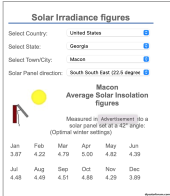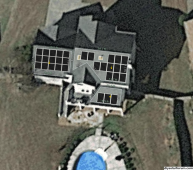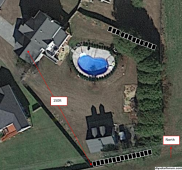tonyandjill
New Member
Hey guys,
I have been collecting info here and other places on solar components and sizing and i have an idea based on my consumption what i think is appropriate. Just want to hear from people here.
My consumption is pretty high even though imo we are pretty conservative with the thermostats. (82F summer, 67F winter). Average from January to october was 1242kwh/mo, 41.4kwh/day. I have a pool and 4 AC units. (I would love to overspec this system so that i can finally turn the temp down in the summer and up in the winter if possible!!)
I'll ideally be adding 2 electric vehicles eventually, but getting rid of one of the 5ton HVAC units and replacing with a mini-split. Possibly doing the same for a 3ton. Together, we only drive about 20-40 miles a day on average so hopefully the cars wouldn't add a huge load.
Also, my roof faces SE and the slope is 45 degrees, which i think is great for my latitude. I also have some room for panels on the ground.
The city i live in only allows 10kw of panels, anything above that and you have to go off grid. i've talked to the power co. and they are adamant. So, my thinking is that if i'm going to do this, 10kw would not be worth it. So if i do go off grid, i need to be sure i never run out of power (wife angry).
So, here are the components im considering right now:
Panels: 30kw of bifacial panels (Philadelphia Solar 400W PS-M108(HCBF), half on the roof, half on the ground - around $8k from inxeption.com
I've been following a guy that bought panels from inxeption. the company seems legit, they just sell a lot of brands ive never heard of.
Inverters: Either two EG4 18kpv inverters - $10,400
The 18KPV's look amazing and i'm leaning that way for sure over the megarevo's. but if there are enough people out there that say the MR's are ok, i might consider them.
- or -
3 Megarevo R10KLNA - around $8k from china with shipping.
(I would like to hear from people that have had good experience with MR, if there are any lol. Ive read a lot of the posts about the issues, there are quite a few.)
Batteries: Either six 5kwh EG4-LL's from signature - $9500
-or-
four 15kwh batteries from china ~ $8k with shipping
There are a few chinese battery companies ive spoken with that are willing to send video of the batteries with their qr codes, serial numbers and a sticker with my name on them (to ensure it isnt just stock footage) and the full capacity of the battery shown on the display. For example, for a 280Ah battery i think the capacity for a new battery should be around 306Ah or something like that. Of course this still doesnt guarantee anything, that's why i'd love to hear from someone that has purchased successfully from CHina.
Anyway, i would appreciate any insight on my sizing and component selection and any other info you want to throw in there. TIA
I have been collecting info here and other places on solar components and sizing and i have an idea based on my consumption what i think is appropriate. Just want to hear from people here.
My consumption is pretty high even though imo we are pretty conservative with the thermostats. (82F summer, 67F winter). Average from January to october was 1242kwh/mo, 41.4kwh/day. I have a pool and 4 AC units. (I would love to overspec this system so that i can finally turn the temp down in the summer and up in the winter if possible!!)
I'll ideally be adding 2 electric vehicles eventually, but getting rid of one of the 5ton HVAC units and replacing with a mini-split. Possibly doing the same for a 3ton. Together, we only drive about 20-40 miles a day on average so hopefully the cars wouldn't add a huge load.
Also, my roof faces SE and the slope is 45 degrees, which i think is great for my latitude. I also have some room for panels on the ground.
The city i live in only allows 10kw of panels, anything above that and you have to go off grid. i've talked to the power co. and they are adamant. So, my thinking is that if i'm going to do this, 10kw would not be worth it. So if i do go off grid, i need to be sure i never run out of power (wife angry).
So, here are the components im considering right now:
Panels: 30kw of bifacial panels (Philadelphia Solar 400W PS-M108(HCBF), half on the roof, half on the ground - around $8k from inxeption.com
I've been following a guy that bought panels from inxeption. the company seems legit, they just sell a lot of brands ive never heard of.
Inverters: Either two EG4 18kpv inverters - $10,400
The 18KPV's look amazing and i'm leaning that way for sure over the megarevo's. but if there are enough people out there that say the MR's are ok, i might consider them.
- or -
3 Megarevo R10KLNA - around $8k from china with shipping.
(I would like to hear from people that have had good experience with MR, if there are any lol. Ive read a lot of the posts about the issues, there are quite a few.)
Batteries: Either six 5kwh EG4-LL's from signature - $9500
-or-
four 15kwh batteries from china ~ $8k with shipping
There are a few chinese battery companies ive spoken with that are willing to send video of the batteries with their qr codes, serial numbers and a sticker with my name on them (to ensure it isnt just stock footage) and the full capacity of the battery shown on the display. For example, for a 280Ah battery i think the capacity for a new battery should be around 306Ah or something like that. Of course this still doesnt guarantee anything, that's why i'd love to hear from someone that has purchased successfully from CHina.
Anyway, i would appreciate any insight on my sizing and component selection and any other info you want to throw in there. TIA






